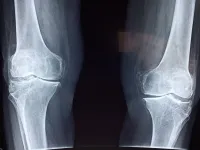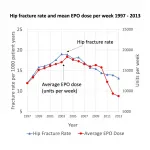INFORMATION:
This work was supported by a Wellcome Trust Strategic Award (101123/Z/13/A) and by Mrs Janice Gibson and the Ernest Heine Family Foundation.
This work is part of an international collaboration with researchers from University of Queensland, Imperial College London, The Wellcome Trust Sanger Institute, Cambridge, the Institute of Translational Genomics, Munich, King's College London, Guy's Hospital, London, the New York Genome Center, New York , Erasmus MC, Netherlands, and McGill University, Canada.
New map reveals genes that control the skeleton
Researchers have mapped the gene activity of osteocytes to improve their understanding of skeletal disease
2021-05-05
(Press-News.org) Research led by the Garvan Institute of Medical Research has for the first time mapped the unique genetic profile of the skeleton's 'master regulator' cells, known as osteocytes.
The study published today in Nature Communications outlines the genes that are switched on or off in osteocytes, a type of bone cell that controls how other types of cells make or break down parts of the skeleton to maintain strong and healthy bones.
"This new information provides a kind of genetic shortlist we can look to when diagnosing bone diseases that have a genetic component," says the study's first author Dr Scott Youlten, Research Officer in the Bone Biology Lab. "Identifying this unique genetic pattern will also help us find new therapies for bone disease and better understand the impacts of current therapies on the skeleton."
A first look at the osteocyte transcriptome
The skeleton is a highly dynamic structure that changes shape and composition throughout a person's life. Osteocytes are the most abundant cell type in bone but have proved difficult to study because they are embedded within the hard mineral structure of the skeleton.
Inside the bone, osteocytes form a network similar in scale and complexity to the neurons in the brain (with over 23 trillion connections between 42 billion osteocytes) that monitors bone health and responds to ageing and damage by signalling other cells to build more bone or break down old bone. Diseases such as osteoporosis and rare genetic skeletal disorders arise from an imbalance in these processes.
To understand what genes are involved in controlling bone build-up or breakdown, the researchers isolated bone samples from different skeletal sites of experimental models to measure the average gene activity in osteocytes. Through this, they mapped a comprehensive osteocyte 'signature' of 1239 genes that are switched on in osteocytes and that distinguish them from other cells. 77% of these genes have no previously known role in the skeleton and many were completely novel and only found in these critical cells.
"Many of the genes we saw enriched in osteocytes are also found in neurons, which is interesting given these cells share similar physical characteristics and may suggest they are more closely related than we previously thought," explains Dr Youlten.
A comparison of the osteocyte signature genes with human genetic association studies of osteoporosis identify new genes that maybe associated with susceptibility to this common skeleton disease. Furthermore many of these osteocyte genes were also shown to cause rare bone diseases.
"Mapping the osteocyte transcriptome could help clinicians and researchers more easily establish whether a rare bone disease has a genetic cause, by looking through the 'shortlist' of genes known to play an active role in controlling the skeleton," says Dr Youlten.
The big picture view
Co-senior author Professor Peter Croucher, Deputy Director of the Garvan Institute and Head of the Bone Biology Lab, says that "the osteocyte transcriptome map gives researchers a picture of the whole landscape of genes that are switched on in osteocytes for the first time, rather than just a small glimpse".
"The majority of genes that we've found to be active within osteocytes had no previously known role in bones. This discovery will help us understand what controls the skeleton, which genes are important in rare and common skeletal diseases and help us identify new treatments that can stop development of bone disease and also restore lost bone."
ELSE PRESS RELEASES FROM THIS DATE:
Cryptic sense of orientation of bats localised: the sixth sense of mammals lies in the eye
2021-05-05
Mammals see with their eyes, hear with their ears and smell with their nose. But which sense or organ allows them to orient themselves on their migrations, which sometimes go far beyond their local foraging areas and therefore require an extended ability to navigate? Scientific experiments led by the Leibniz Institute for Zoo and Wildlife Research (Leibniz-IZW), published together with Prof. Richard A. Holland (Bangor University, UK) and Dr. Gunārs P?tersons (Latvia University of Life Sciences and Technologies) now show that the cornea of the eyes is the location of such an important sense in migrating bats. If the cornea is anaesthetised, the otherwise ...
New marker predicts benefit of radiotherapy for early-stage breast cancer
2021-05-05
A study involving researchers at Karolinska Institutet and Gothenburg University in Sweden has found that low levels of a protein called PDGFRb are associated with particularly good results of radiotherapy in women with early-stage breast cancer. The study, which is published in the journal Clinical Cancer Research, also suggests that the efficacy of radiotherapy can be improved with drugs that block this protein.
Some 900 women in Sweden are diagnosed with DCIS (ductalcarcinoma in situ), the earliest possible form of invasive breast cancer. Standard treatment is ...
Reduced kidney function linked to increased risk of dementia
2021-05-05
MINNEAPOLIS - Chronic kidney disease is when a person's kidneys progressively lose their ability to filter waste from the blood and eliminate fluids. Now a new study has found that people with reduced kidney function may have an increased risk of developing dementia. The study is published in the May 5, 2021, online issue of Neurology®, the medical journal of the American Academy of Neurology.
Chronic kidney disease affects approximately 15% of adults in the United States and it is more common as people age. However, since many people don't experience ...
Total knee replacement may be more painful for vitamin-D deficient postmenopausal women
2021-05-05
CLEVELAND, Ohio (May 5, 2021)--Vitamin D is a critical part of a healthy diet. Among other benefits, it has been shown to protect against bone disease and maintain soft tissue health. A new study suggests that it may also play a role in the degree of postoperative pain postmenopausal women experience after undergoing total knee replacement. Study results are published online today in Menopause, the journal of The North American Menopause Society (NAMS).
Vitamin D deficiency is a major issue globally. It is estimated that 60% of adults have insufficient levels of the bone-building vitamin. Estrogen deficiency in perimenopausal women has been associated with decreased levels of vitamin D. A sedentary lifestyle and lack of sun exposure have also been shown to contribute to vitamin D ...
Which medications are most toxic to the liver?
2021-05-05
A new study published in the British Journal of Clinical Pharmacology ¬provides insights on how common hospitalized patients develop liver injury from taking different medications.
When investigators analyzed the records of 156,570 hospitalized patients, they found 499 cases of drug-induced liver injury (DILI), for an incidence of 0.32%. Anti-infective agents, cancer medications, and nonsteroidal anti-inflammatory drugs were the major categories of drugs causing DILI, and the highest incidence was due to voriconazole (an antifungal medication). Patients with high cholesterol, cardiovascular disease, ...
Study uncovers potentially avoidable acute care use for vaccine-preventable illnesses in lupus patients
2021-05-05
A new study published in Arthritis Care & Research indicates that few individuals with the autoimmune disease lupus who were publicly insured through Medicaid received recommended vaccines in 2000-2010. Also, those who were unvaccinated needed more acute care for vaccine-preventable illnesses.
From 2000-2010, there were 1,290 patients who visited the emergency department or were hospitalized for vaccine-preventable illness, and 93% of these visits occurred in patients without billing codes for related vaccinations. Patients who were Black had a 22% higher risk of needing such care than those who were white.
"These episodes represent missed opportunities to deliver essential ...
More studies needed on mental health treatments during and after pregnancy
2021-05-05
Untreated mental health disorders can be a serious problem for women and their children during pregnancy and after giving birth, during the postpartum period. A recent analysis funded by the Agency for Healthcare Research and Quality (AHRQ) and published in Psychiatric Research & Clinical Practice notes that few studies have examined the benefits of medications for mental health disorders in pregnant and postpartum women. And while many studies have reported on potential harms, the large majority could not separate the effect of medications from the effect of the underlying disorder. As a result, it ...
Do bacteria in the mouth affect risk of developing rheumatoid arthritis?
2021-05-05
Investigators found similarities in the bacterial composition of the mouth among patients with early rheumatoid arthritis and those at risk of developing the disease, compared with healthy individuals who were not at risk. The findings come from a study published in Arthritis & Rheumatology.
Patients and at-risk individuals had an increased relative abundance of potentially pro- inflammatory bacteria in the mouth, suggesting a possible link between oral microbes and rheumatoid arthritis.
"Prevotella and Veillonella--both gram-negative anaerobes--were at higher relative abundance in saliva, and ...
Erythropoietin treatments may increase hip fracture risk in patients with kidney failure
2021-05-05
Erythropoietin (EPO) is a medication used to stimulate the production of new red blood cells, which is impaired in individuals with kidney failure. Unfortunately, however, the treatment may increase the risk of hip fractures.
In an analysis published in the Journal of Bone and Mineral Research that examined 1997-2013 records from two large U.S. databases, investigators found that EPO doses administered to patients with kidney failure on hemodialysis fluctuated widely over time, and hip fracture rates closely tracked the average dose of EPO doses used in patients.
"Patients with renal failure can benefit from EPO treatment; however, as with all medications, ...
How accurate are virtual assessments of cognitive function?
2021-05-05
Virtual care provided through telephone or videoconference has been broadly implemented in recent months because of the COVID-19 pandemic. A new analysis of published studies has examined the accuracy and reliability of virtual compared with in-person cognitive assessments for diagnosing dementia or mild cognitive impairment.
The analysis, which is published in the Journal of the American Geriatrics Society, included 121 studies. Three studies comparing videoconference with in-person cognitive assessments demonstrated good reliability and accuracy of virtual cognitive assessments in diagnosing dementia. Investigators ...
LAST 30 PRESS RELEASES:
Study: Teens use cellphones for an hour a day at school
After more than two years of war, Palestinian children are hungry, denied education and “like the living dead”
The untold story of life with Prader-Willi syndrome - according to the siblings who live it
How the parasite that ‘gave up sex’ found more hosts – and why its victory won’t last
When is it time to jump? The boiling frog problem of AI use in physics education
Twitter data reveals partisan divide in understanding why pollen season's getting worse
AI is quick but risky for updating old software
Revolutionizing biosecurity: new multi-omics framework to transform invasive species management
From ancient herb to modern medicine: new review unveils the multi-targeted healing potential of Borago officinalis
Building a global scientific community: Biological Diversity Journal announces dual recruitment of Editorial Board and Youth Editorial Board members
Microbes that break down antibiotics help protect ecosystems under drug pollution
Smart biochar that remembers pollutants offers a new way to clean water and recycle biomass
Rice genes matter more than domestication in shaping plant microbiomes
Ticking time bomb: Some farmers report as many as 70 tick encounters over a 6-month period
Turning garden and crop waste into plastics
Scientists discover ‘platypus galaxies’ in the early universe
Seeing thyroid cancer in a new light: when AI meets label-free imaging in the operating room
Neutrophil-to-lymphocyte ratio may aid risk stratification in depressive disorder
2026 Seismological Society of America Annual Meeting
AI-powered ECG analysis offers promising path for early detection of chronic obstructive pulmonary disease, says Mount Sinai researchers
GIMM uncovers flaws in lab-grown heart cells and paves the way for improved treatments
Cracking the evolutionary code of sleep
Medications could help the aging brain cope with surgery, memory impairment
Back pain linked to worse sleep years later in men over 65, according to study
CDC urges ‘shared decision-making’ on some childhood vaccines; many unclear about what that means
New research finds that an ‘equal treatment’ approach to economic opportunity advertising can backfire
Researchers create shape-shifting, self-navigating microparticles
Science army mobilizes to map US soil microbiome
Researchers develop new tools to turn grain crops into biosensors
Do supervised consumption sites bring increased crime? Study suggests that’s a myth
[Press-News.org] New map reveals genes that control the skeletonResearchers have mapped the gene activity of osteocytes to improve their understanding of skeletal disease


